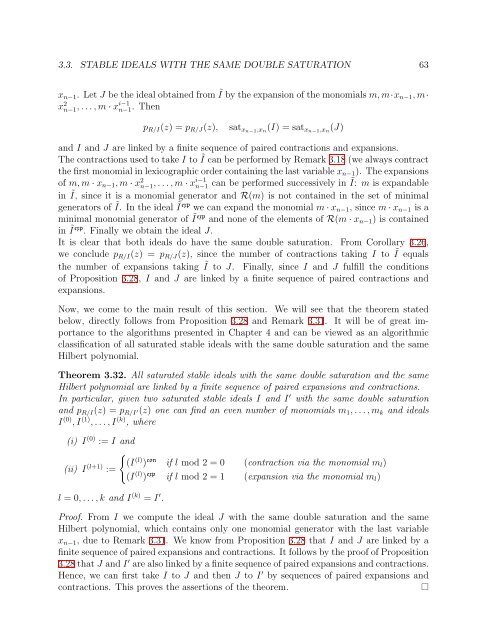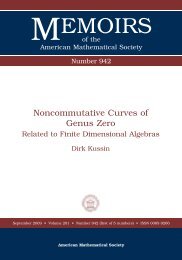University of Paderborn Department of Mathematics Diploma Thesis ...
University of Paderborn Department of Mathematics Diploma Thesis ...
University of Paderborn Department of Mathematics Diploma Thesis ...
Create successful ePaper yourself
Turn your PDF publications into a flip-book with our unique Google optimized e-Paper software.
3.3. STABLE IDEALS WITH THE SAME DOUBLE SATURATION 63x n−1 . Let J be the ideal obtained from Ĩ by the expansion <strong>of</strong> the monomials m, m·x n−1, m·x 2 n−1, . . . , m · x i−1n−1. Thenp R/I (z) = p R/J (z),sat xn−1 ,x n(I) = sat xn−1 ,x n(J)and I and J are linked by a finite sequence <strong>of</strong> paired contractions and expansions.The contractions used to take I to Ĩ can be performed by Remark 3.18 (we always contractthe first monomial in lexicographic order containing the last variable x n−1 ). The expansions<strong>of</strong> m, m · x n−1 , m · x 2 n−1, . . . , m · x i−1n−1 can be performed successively in Ĩ: m is expandablein Ĩ, since it is a monomial generator and R(m) is not contained in the set <strong>of</strong> minimalgenerators <strong>of</strong> Ĩ. In the ideal Ĩexp we can expand the monomial m · x n−1 , since m · x n−1 is aminimal monomial generator <strong>of</strong> Ĩexp and none <strong>of</strong> the elements <strong>of</strong> R(m · x n−1 ) is containedin Ĩexp . Finally we obtain the ideal J.It is clear that both ideals do have the same double saturation. From Corollary 3.26,we conclude p R/I (z) = p R/J (z), since the number <strong>of</strong> contractions taking I to Ĩ equalsthe number <strong>of</strong> expansions taking Ĩ to J. Finally, since I and J fulfill the conditions<strong>of</strong> Proposition 3.28, I and J are linked by a finite sequence <strong>of</strong> paired contractions andexpansions.Now, we come to the main result <strong>of</strong> this section. We will see that the theorem statedbelow, directly follows from Proposition 3.28 and Remark 3.31. It will be <strong>of</strong> great importanceto the algorithms presented in Chapter 4 and can be viewed as an algorithmicclassification <strong>of</strong> all saturated stable ideals with the same double saturation and the sameHilbert polynomial.Theorem 3.32. All saturated stable ideals with the same double saturation and the sameHilbert polynomial are linked by a finite sequence <strong>of</strong> paired expansions and contractions.In particular, given two saturated stable ideals I and I ′ with the same double saturationand p R/I (z) = p R/I ′(z) one can find an even number <strong>of</strong> monomials m 1 , . . . , m k and idealsI (0) , I (1) , . . . , I (k) , where(i) I (0) := I and{(ii) I (l+1) (I (l) ) con if l mod 2 = 0 (contraction via the monomial m l ):=(I (l) ) exp if l mod 2 = 1 (expansion via the monomial m l )l = 0, . . . , k and I (k) = I ′ .Pro<strong>of</strong>. From I we compute the ideal J with the same double saturation and the sameHilbert polynomial, which contains only one monomial generator with the last variablex n−1 , due to Remark 3.31. We know from Proposition 3.28 that I and J are linked by afinite sequence <strong>of</strong> paired expansions and contractions. It follows by the pro<strong>of</strong> <strong>of</strong> Proposition3.28 that J and I ′ are also linked by a finite sequence <strong>of</strong> paired expansions and contractions.Hence, we can first take I to J and then J to I ′ by sequences <strong>of</strong> paired expansions andcontractions. This proves the assertions <strong>of</strong> the theorem.
















